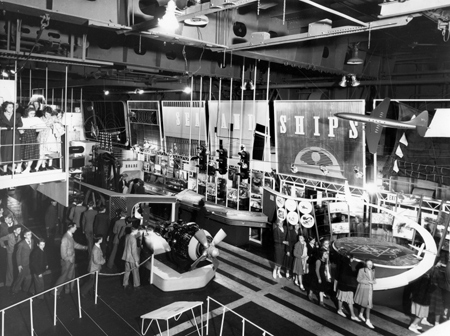
Working Boats from Around the British Coast, Mural of the Nelson Bar, HMS Campania, 1951
Unframed (ref: 5357)
Signed
Oil on 5 panels
122 x 914.4 cm (48 x 360 in.)

Signed
Oil on 5 panels
122 x 914.4 cm (48 x 360 in.)
Provenance: Selected by Sir Frederick Gibberd as a gift to Harlow at the end of the Festival of Britain; with the Harlow Arts Trust until 2009.
Exhibited: A Tonic To the Nation,1976, V&A
Literature: British Murals and Decorative Painting 1920-1960, Sansom & Co, 2013, pp.301-309; Sacha Llewellyn & Richard Sorrell (ed), Alan Sorrell; the Life and Works of an English Neo-Romantic Artist, (Bristol: Sansom & Co.) 2013, pp. 122-125.

The Festival of Britain organisers were keen to reach as wide a section of the public all over Britain as possible. The HMS Campania - an ex- cargo ship converted for wartime use into an aircraft carrier - toured different ports around the coast, carrying an exhibition display by James Holland, an RCA contemporary of Sorrell’s, which was a microcosm of the South Bank. For the 30ft by 4ft mural the theme was the traditional small working boats around the coast of Britain to be carried out in the Fair ground technique to resist exposure to the weather. This mural has not been seen in public since it was shown at the V&A in the 1976 tonic to the Nation exhibition. It has never been seen in colour.
Sorrell received a fee of £315. What is unusual in Sorrell’s painting is a broad vein of comedy traditional to the theme of seafaring subjects, whether in the saucy mermaids supporting the extreme ends or the cattle and single sheep on board the Norfolk wherry. The ‘old salt’ at the left hand end looks through his telescope, at the other end of which a sailor peers back from the far end of the frieze. These figures are similar in character to those with which Rowland Emmett populated his cartoons in Punch at the time. The colour contrast between the blue background and the ochre sails is effective, with the shapes inside the curling ropes slightly darker in tone to establish a spatial differentiation between two alternating sets of subjects. The signwriter’s lettering adds just the right folk-art quality.
The design drawing for the installation shows the mural running in one continuous piece across the back of the bar, within a mirrored frame. This must have been deemed impractical, and the photographs show that the bar has a back fitting with holes in which bottles are stored. The mural was divided in half, and instead of facing the customers at the bar formed a frieze above the bench seating on either side, which would have diminished the continuity of the design and presumably accounts for the fact that a small section seems to be missing from the centre, as the two halves fail to meet.
We are grateful to Richard Sorrell and Alan Powers for assistance